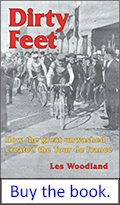

Strategies for Dealing with Flat Tires
by John Neugent
Tech articles | Commentary articles | Product Manager series part 3
The late John Neugent probably knew more about bicycle wheels than anyone else. Maybe more about bikes as well. He spent his life in the bike business, at every level. He owned Neugent Cycling, a firm devoted to delivering world-class equipment at the lowest possible price. —Chairman Bill

John Neugent
This may be an odd topic for some, but for many riders, dealing with flat tires is a hassle. Tires have become more difficult to mount over the last 20 years as rim profiles changed. Now many people are running tubeless so a common question is “are my wheels tubeless compatible”. For that reason, I only use tubeless compatible rims. It has raised internal “shoulders” to help seat the bead. When you pump up the tire either with or without a tube, the beads slide up into a canal. In some cases, with tight beads, it can be very difficult to remove them.

No one likes a flat tire. Here's the great Hennie Kuiper after flatting at the 1983 Paris-Roubaix, which he won.

Les Woodland's book Dirty Feet: How the Great Unwashed Created the Tour de France is available as an audiobook here. For the print and Kindle eBook versions, just click on the Amazon link on the right.
John Neugent continues:
The core of the problem is that there are no industry standards for either rim profiles or bead lengths. The industry continues to work on the issue but it’s still a long way away. So in the meantime it’s good to have a strategy to deal with hard-to-change flats.
The first one, and I highly recommend this unless you are comfortable changing flats, is to use tire sealant. It lasts two years and will fix the vast majority of leaks. As a side benefit to this, your tires will maintain their air pressure much longer so no need to top off your air for every ride. If you are using a tube, you can even run the wheels without sealant until you get a flat, at which time you install the sealant and pump the tire back up.
Many people now are running tubeless tires and like them. They are not for me for now because I really don’t care about their advantages (lower pressures with more safety), and I do dislike cleaning up after one when it’s time to replace it.
Another option, which I am not using but I would strongly consider, is to run tubular tires. Put sealant in when you get a flat, not before. In most cases you can probably wear the tire out before you have to remove it. With clincher tire prices going up there’s not a huge different in tire cost and you have all of the advantages of tubular tires (lighter rims and tires, better rolling resistance (although this may now be debatable).
John Neugent was was one of the first to establish quality hand building in Taiwan around the turn of the century. He now owns Neugent Cycling, a firm devoted to delivering world-class equipment at the lowest possible price.







